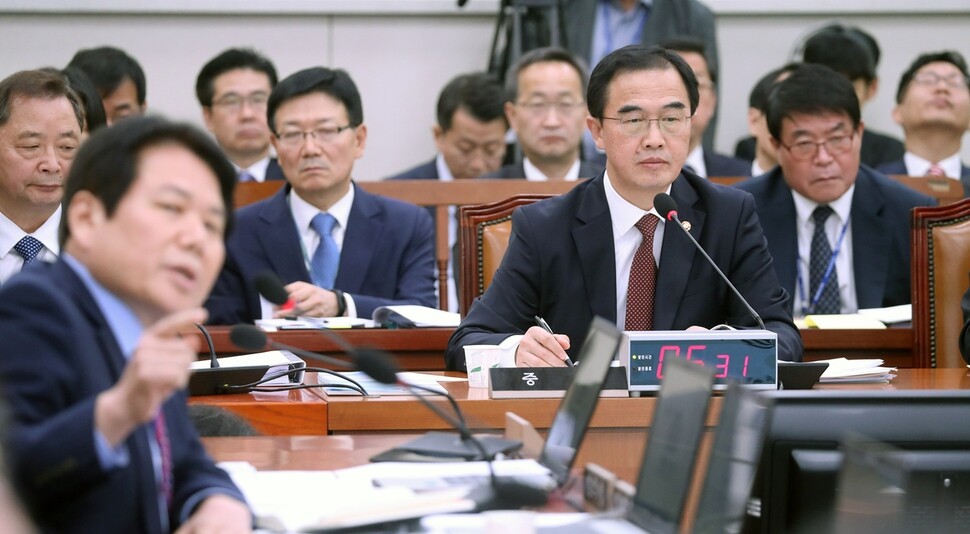hankyoreh
Links to other country sites 다른 나라 사이트 링크
North Korea using small hydroelectric plant to power Kaesong Complex factories

Amid controversy over North Korea’s resumption of operations at some textile factories in the Kaesong Industrial Complex, South Korea’s Unification Minister Cho Myung-gyon said on Oct. 13 that the supply of electricity to the complex is coming from a small hydroelectric power plant in the area that North Korea has apparently activated.
That was the response that Cho provided during the parliamentary audit at the National Assembly’s Foreign Affairs and Unification Committee to Lee Ju-yeong, a lawmaker with the Korea Liberty Party, who asked how the Kaesong Complex could be reactivated when its electricity supply had been cut from a substation in the South Korean city of Paju. Cho said that the South Korean government assumes the complex is being powered by a “hydroelectric plant on the Yeseong River” in North Hwanghae Province.
When asked whether power generators inside the Kaesong Complex had been activated, Cho said that “a number of conjectures are being made” but that “we can’t tell whether only the generators are being used or whether they’re being supplemented with power from the Yeseong River.”
After the US-funded Radio Free Asia reported on Oct. 3 that North Korea was secretly operating 19 textile factories inside the Kaesong Complex, North Korean media said on Oct. 6 that “the factories will run even more vigorously,” hinting that North Korea intends to operate the Kaesong Complex on its own.
“The government had been aware that certain activity was taking place inside the complex, such as vehicle movement and lights being turned on and off.,” Cho said when opposition politicians accused the government of having failed to realize that that North Korea had reopened the Kaesong Complex or to take any kind of action.
“We became aware of that activity in March or April of this year and have been watching to see whether it was aimed at operating the complex, but we didn’t find evidence that was concrete enough to draw that conclusion.” If North Korea has resumed operations at the Kaesong Complex on its own, Cho said, it is a violation of the Inter-Korean Exchange and Cooperation Act and, in some respects, a violation of the UN Security Council Resolution. The question of North and South Korea reopening the Kaesong Complex together is a matter to consider “at the point when the North Korean nuclear issue is moving into the resolution stage,” he added.
The Foreign Affairs and Unification Committee on Oct. 13 witnessed a sharp dispute between opposition party lawmakers, who denounced the Moon administration for its decision to provide US$8 million in humanitarian aid to North Korea through UN agencies such as UNICEF and the World Food Program, and ruling party lawmakers, who spoke of the need to resume inter-Korean dialogue and to set up an inter-Korean hotline.
By Kim Ji-eun, staff reporter
Please direct questions or comments to [english@hani.co.kr]

Editorial・opinion
![[Column] Park Geun-hye déjà vu in Yoon Suk-yeol [Column] Park Geun-hye déjà vu in Yoon Suk-yeol](https://flexible.img.hani.co.kr/flexible/normal/500/300/imgdb/original/2024/0424/651713945113788.jpg) [Column] Park Geun-hye déjà vu in Yoon Suk-yeol
[Column] Park Geun-hye déjà vu in Yoon Suk-yeol![[Editorial] New weight of N. Korea’s nuclear threats makes dialogue all the more urgent [Editorial] New weight of N. Korea’s nuclear threats makes dialogue all the more urgent](https://flexible.img.hani.co.kr/flexible/normal/500/300/imgdb/original/2024/0424/7317139454662664.jpg) [Editorial] New weight of N. Korea’s nuclear threats makes dialogue all the more urgent
[Editorial] New weight of N. Korea’s nuclear threats makes dialogue all the more urgent- [Guest essay] The real reason Korea’s new right wants to dub Rhee a founding father
- [Column] ‘Choson’: Is it time we start referring to N. Korea in its own terms?
- [Editorial] Japan’s rewriting of history with Korea has gone too far
- [Column] The president’s questionable capacity for dialogue
- [Column] Are chaebol firms just pizza pies for families to divvy up as they please?
- [Column] Has Korea, too, crossed the Rubicon on China?
- [Correspondent’s column] In Japan’s alliance with US, echoes of its past alliances with UK
- [Editorial] Does Yoon think the Korean public is wrong?
Most viewed articles
- 1‘We must say no’: Seoul defense chief on Korean, USFK involvement in hypothetical Taiwan crisis
- 2N. Korean delegation’s trip to Iran shows how Pyongyang is leveraging ties with Moscow
- 3Amnesty notes ‘erosion’ of freedom of expression in Korea in annual human rights report
- 4[Column] Park Geun-hye déjà vu in Yoon Suk-yeol
- 5‘Weddingflation’ breaks the bank for Korean couples-to-be
- 6[Reportage] On US campuses, student risk arrest as they call for divestment from Israel
- 7[Editorial] New weight of N. Korea’s nuclear threats makes dialogue all the more urgent
- 8Korea sees more deaths than births for 52nd consecutive month in February
- 9Will NewJeans end up collateral damage in internal feud at K-pop juggernaut Hybe?
- 10Why Korea shouldn’t welcome Japan’s newly beefed up defense cooperation with US